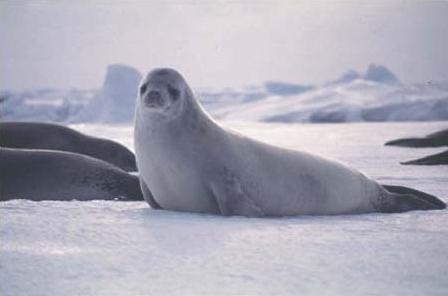
On this page
- UNEP Effects Panel meeting in Wellington
- The ocean in the 21st Century and beyond
- Waves, sediment and ecology
- Hydrodynamics of mussel farms
- Coastal and Storm Hazards Workshop
- UV Radiation and Its Effects: an update
- NIWA Sponge Taxonomy Workshop – University of Mississippi
UNEP Effects Panel meeting in Wellington, 24 February to 4 March 2002
The next meeting of the United Nations Environment Programme (UNEP) Effects Panel will be held in Wellington from 24 February to 4 March 2002, and will be hosted by NIWA at Greta Point. The local organiser is Dr Richard McKenzie (NIWA, Lauder), who is a member of the panel.
The panel is required to report at regular intervals on the environmental effects of ozone depletion to the parties of the Montreal Protocol on Protection of the Ozone Layer. The objective of the Wellington meeting is to complete a draft report summarising important findings and new develop-ments since the last report in 1998, with special emphasis on interactions between ozone depletion and global warming. The final report is due to be released by the end of 2002.
The panel comprises approximately 30 members at present (listed in UNEP 1998). Although the meeting is not open to the public, some panel members may be willing to take the opportunity to visit other institutions in New Zealand.
The last full report of this panel was published as:
UNEP (1998). Environmental effects of ozone depletion: 1998 assessment. Journal of Photochemistry and Photobiology B: Biology 46(1–3): 1–108.
For further information, contact Richard McKenzie [ [email protected] ] Phone +64 3 447 3411 Fax +64 3 447 3348
The ocean in the 21st Century and beyond
The international consensus is that Earth is warming rapidly under a cloak of greenhouse gases. Predictions point to continued warming of the air and ocean but the rates and impacts of this trend will vary regionally. In the case of New Zealand, our data show the ocean is changing slowly but this trend is masked by large climatic fluctuations such as those associated with the El Niño–Southern Oscillation (ENSO) and, potentially, the Interdecadal Pacific Oscillation (IPO).
Future effects of these large fluctuations are uncertain, however, mainly because records are too short for confident projections. For instance, although ENSO events are predicted to continue at a similar or slightly increased intensity through to 2100, their behaviour when they coincide with an IPO period is not well established. While mindful of the uncertainties, we anticipate the following responses by New Zealand climate and ocean.
- Models of atmospheric climate project a temperature increase of 2°C for this century, based on mid-range scenarios of greenhouse gas and aerosol concentrations. Westerly winds are set to increase, intensifying the present rainfall pattern of “wet in the west and dry in the east”, although this may be modified during an IPO period.
- Most global warming models predict a weakening of the thermohaline circulation system due to reduced deep-water formation in the Northern Hemisphere. Such a change will alter the transfer of heat at varying time scales, taking up to several centuries to reach the New Zealand region.
- Model projections for subtropical winds show little variation, suggesting no major modification of warm ocean currents along the eastern North Island. However, westerly winds over the Southern Ocean may increase, thus enhancing some coastal currents and the cold Antarctic Circumpolar Current.
- Observations are too few to predict change in biological production, but there may be a response to ENSO events. Off eastern New Zealand, production may increase in El Niño and decline during La Niña phases. In the last warm phase (120,000 years ago), a major, long-term change in production occurred on Campbell Plateau where mixed animal-plant plankton were replaced by carbonate-producing plants, thus enhancing the transfer of carbon to the seabed.
- The natural variability in sea level due to tides, storm surges and other phenomena masks a sea-level rise of 1 to 2 mm per year which has been occurring in a warming world over the last century.
- The long-term increase in sea temperatures is masked by short-term fluctuations such as daily heating, seasons, ENSO, IPO and other phenomena. For events longer than a year, temperatures are dominated by ENSO, which is predicted to continue at similar or slightly higher intensities through 2100, although intensities are uncertain in IPOs.
- Nevertheless, the sea surface is warming, having increased by 0.6°C over the last century. A pause in this trend during the last two decades probably relates to more frequent and intense El Niños. However, the general warming trend is consistent with IPCC data and projections for the next century.
- The capacity of the Southern Ocean to store carbon dioxide will reduce as waters become warmer and more strongly layered. These changes will affect the transfer of carbon to ocean depths by reducing gas solubility and ocean mixing as well as potentially altering the biological pump (growth and sinking of plankton).
You can find more details on each of these topics in articles appearing in this issue of Water & Atmosphere. The issue is devoted to accounts of the latest NIWA research into climate change and its effect on the ocean around New Zealand, starting with an introductory article on page 7.
Changing Oceans Research Team
Waves, sediment and ecology
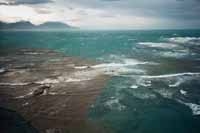
Highly turbid regions (brown colour) hinder the settlement and propagation of marine plants on shallow rocky reefs.
A team of scientists from NIWA and the University of Canterbury recently conducted a unique interdisciplinary experiment near Kaikoura. The physicists and ecologists joined forces to measure the interaction between the physical and biological processes that influence life and survival on the rocky shoreline. These processes have an intimate bearing on biodiversity and the ability of the ecosystem to respond to external threats, particularly high sediment levels. These sediments are eroded from disturbed land catchments, discharged to the coastal ocean by streams and rivers, and finally delivered to reefs by nearshore circulation patterns.
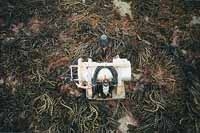
Instrument to measure wave force, sediment, temperature and salinity located amongst the algal plant Hormosira (Neptune’s necklace).
Wave conditions can vary immensely along this rocky shore – large ocean swell can pound the exposed parts of the reef allowing only the most robust marine plants (and scientific instruments) to survive. Within a short distance in more sheltered areas, a quite different ecosystem may flourish. In both the exposed and sheltered habitats, too much sediment may prevent algae – seaweeds – from settling and growing on rocks. Since the seaweeds form habitat for other plants and animals, this can have trickle-down effects on the biodiversity and functioning of the whole rocky-reef ecosystem. In order to describe the environment around the rocks, measurements were made of wave properties, water velocities, and sedimentation using sophisticated acoustic instruments underwater and radar from above. Ecologists from the University of Canterbury examined the ability of microscopic seaweed germlings to settle and attach to rock under various wave and sediment conditions. The primary purpose of this pilot experiment was to determine the best way to quantify this interplay between physical and biological conditions, and to assess various methods of measuring waves and sediment in the often extreme conditions.
The information gained from the experiment will guide future field studies to determine the role of sediment and waves in the ecology of the coastal rocky reef. The wider aim of the project is to contribute to environmental management of coastlines and to provide improved mitigation strategies for dealing with threats to that environment. The work is being conducted within NIWA’s FRST-funded research programme “Effects of Sediments on Estuarine and Coastal Ecosystems”.
For further information, contact:
Murray Smith [ [email protected] ] Phone +64 4 386 0300 Fax +64 4 386 2153
or
David Schiel [ [email protected] ] Zoology Department, University of Canterbury
Hydrodynamics of mussel farms
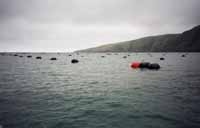
Mussel farm, Pigeon Bay
What are the effects of mussel farms on the hydro-dynamics of the surrounding water? In November 2001, a team of NIWA scientists conducted a pilot field study designed to find out.
Coastal currents and waves are the dominant physical control for many coastal habitats. With applications from the aquaculture industry for ever-larger farms, there is a need to quantify their effects on the currents and waves.
The study team included Craig Stevens (NIWA, Wellington), Bob Spigel (NIWA, Christchurch), David Plew (University of Cantebury/NIWA Centre of Excellence in Aquaculture and Marine Ecology [CEAME]), and Neil Hartstein (University of Auckland/NIWA Institute of Aquatic and Atmospheric Sciences [IAAS]).
The work concentrated on a small farm in Pigeon Bay, Banks Peninsula, and examined such features as flow distortion, stratification disturbance and turbulence gener-ation. The team gathered physical measurements on a range of scales: from the bay scale down to scales comparable to the size of the mussels themselves.
As usual in environmental science, the greatest challenge in analysing the data is separating the influence of the farm structures from the natural variability in the data. The next step will be to examine the effects of the farm structures on waves.
As well as determining the influence of the farm upon the surrounding waters, the work should lead to a better understanding of the nature of flow around these structures. This may lead to farm designs that minimize flow effects and better utilise nutrients. These sorts of smart solutions are required if New Zealand is to enhance mussel production in a sustainable fashion.
For further information contact
Craig Stevens [ [email protected] ] Phone +64 4 386 0300 Fax +64 4 386 2153
or
Bob Spigel [ [email protected] ] Phone +64 3 348 8987 Fax +64 3 348 5548
Coastal and Storm Hazards Workshop

Waves off Timaru, 20 July 2001 (Photo: © John Bisset, Timaru Herald)
Do you have an interest in coastal hazards? Has our planning for coastal margins kept up with the latest findings on hazards? What is “coastal squeeze”? What effect will global warming have on our coast? Are storms likely to increase?
These questions, and more, will be addressed by the Coastal and Storm Hazards Workshop to be run by NIWA in Hamilton on 25–26 March 2002.
The workshop will comprise brief research and sector perspectives on current knowledge and practice, along with facilitated workshops. The idea is to build and shape the information base and insights that are needed in the next 5–10 years to allow better management of our coastal margins and to help reduce the impacts of hazards. A range of hazards will be covered, including coastal erosion, storm surge, coastal flooding, damaging waves, cyclones and storms, sea-level rise, other climate change impacts, tsunami, extreme tides, surf rips and maritime hazards (navigation, search and rescue, oil spills).
The workshop is particularly targeted at regional council and territorial authority staff (planners and engineers), consulting engineers and Government agencies.
For further information and a brochure, contact
Rob Bell [ [email protected] ] Phone +64 7 856 7026 Fax +64 7 856 0151
UV Radiation and Its Effects: an update
A Workshop at the Antarctic Centre, Christchurch, 26–28 March 2002
UV radiation is by nature a crossroads between many disciplines, including atmos-pheric chemistry and physics, botany, zoology, materials science, health. Policy advisers, manufacturers, educationalists and the media also have an interest in UV and its effect. These diverse groups rarely have a chance to interact.
The aim of this meeting, to be convened by NIWA on 26–28 March 2002, is to provide a forum for discussion among groups involved with all aspects of the causes and effects of changes in UV radiation, from CFCs through PSCs to DNA and beyond. The workshop will include panel discussions to identify future needs for research in this area. It will be organised along similar lines to the two very successful UV workshops held in 1993 and 1997, which were sponsored by the Royal Society of New Zealand and the National Science Strategy Committee on Climate Change.
Extended abstracts of the talks will be incorporated into a Summary Report, which will include a bibliography of recent research into UV radiation and its effects in New Zealand. The summary will be distributed to all registrants.
Presentations will include the following topics:
- ozone depletion in Antarctica and New Zealand
- UV in New Zealand: variabilities and relationship to other locations
- dissemination of UV information to the public
- effects of UV on human health and impacts on terrestrial and aquatic plants, animals
and ecosystems
- impacts on materials (e.g. paint, plastics, textiles)
- impacts on atmospheric chemistry and biogeochemical cycles
- relationship between ozone depletion and global warming
- future trends in ozone and UV.
or contact
Graeme Strang [ [email protected] ] Phone +64 3 447 3411 Fax +64 3 447 3348
NIWA Sponge Taxonomy Workshop – University of Mississippi
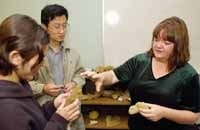
Dr Michelle Kelly Shanks (right) with two workshop participants.
Dr Michelle Kelly Shanks from NIWA, Auckland, recently returned from the United States where she led a 3-day workshop at the University of Mississippi to teach biomedical research scientists to identify Indo-Pacific and Atlantic sponge species – a key step to unlocking the medical potential of these primitive creatures. The workshop was organised at the request of Dr Mark Hamann, from the University’s Department of Pharmacognosy. Dr Hamann and his group of staff and students have been working for some time on extracting compounds from sponges, to fight against infectious diseases such as smallpox, tuberculosis and malaria.
The workshop was truly international with participants from India, Pakistan, Egypt, China, Japan, Korea, USA, Indonesia and Nigeria. Many students were pharma-cologists and had basic knowledge of plant taxonomy, but some had no experience with either microscopy or animals. Dr Bo Tam, a synthetic chemist from China, said, “I came here thinking that sponges were plants – but now I know they’re animals. They are so beautiful, just like flowers!”
This is the latest in a series of workshops run by Dr Kelly Shanks (see Water & Atmosphere 7(3): 9). It was taught using a combination of lectures and practical lab exercises to help the workshop participants recognise characteristics that help to identify sponge species. After three intensive days the participants were able to identify the different sponge species that they were working on for their own research.
“I was very impressed by the enthusiasm and dedication of the group,” said Dr Kelly Shanks.
For further information, contact:
Michelle Wilkinson or Michelle Kelly Shanks [ [email protected] ] Phone +64 9 375 2050 Fax +64 9 375 2051
